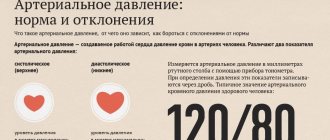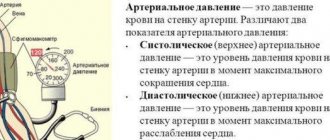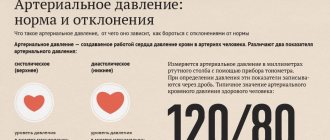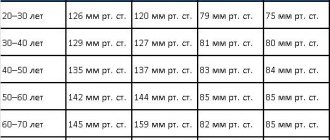From this article you will learn: why there can be high upper blood pressure with normal lower blood pressure. At what age does this most often occur, how to establish a diagnosis, how dangerous this pathology is, and how to treat it.
Author of the article: Yachnaya Alina, oncologist surgeon, higher medical education with a degree in General Medicine.
Article publication date: 05/05/2017
Article updated date: 02/05/2020
An increase in only the upper pressure is called isolated systolic arterial hypertension (abbreviated as ISAH). The identification of such hypertension as a separate type is associated with the difference in the mechanism of its development (compared to “classical”), in the effect on target organs (kidneys, heart, retina, brain) and in the prognosis.
The incidence of ISAH is 2.4–14%, the main contingent of cases is over 60 years of age. The increase in the percentage of this form of hypertension directly depends on age, and by the age of 70–80 years it is diagnosed in more than 80% of patients with arterial hypertension.
The reason for the increase in upper (systolic) pressure, while maintaining normal lower (diastolic) pressure, is a decrease in the distensibility of the main arterial vessels, especially the aorta, as the main one. Under physiological norms, the central arteries, due to their elasticity, accept and suppress the force of cardiac output, uniformly passing blood further throughout the body. If the aortic wall becomes rigid, higher pressure is needed to “push” blood out of the heart, while the function of small vessels does not suffer and the level of diastolic tension remains the same.
Increased pressure in the central arteries leads to a number of pathological changes:
- The growth of muscle tissue (hypertrophy) of the left ventricle with a gradual decrease in its function is a failure of the heart.
- Violation of the “smoothness” and speed of blood distribution through large arteries (decreased blood supply to organs).
- Traumatization of the inner layer of blood vessels (endothelium) by blood flow under high pressure leads to the replacement of the damaged area with connective tissue, increasing the rigidity of the vessel and aggravating the disease.
- Production of active enzymes (renin, angiotensin, nitric oxide, etc.). Their effect on the vascular wall in conditions of disease leads to an increase in pressure and forms a pathological circle.
Why is this dangerous? High blood pressure is the cause of insufficient blood flow in target organs:
| Organ | Pathology |
| Heart | Chronic failure does not allow one to fully cope with simple physical activities (climbing stairs, cleaning the house, etc.). Acute failure (heart attack) with extensive damage leads to rapid death, and if treated, it leads to chronic failure of the heart muscle. |
| Brain | Chronic deficiency is the cause of a gradual decline in mental abilities (intelligence, memory, etc.) Acute deficiency (stroke) can lead to death or severe disability with loss of the ability to care for oneself |
| Kidneys | Chronic failure leads to the proliferation of connective tissue with a gradual decrease in function. The acute form is erased, provided that both kidneys are functional |
| Retina | The chronic form is characterized by a gradual decrease in visual acuity. The acute form is the cause of complete blindness within a short period of time. |
In hypertension, when the upper pressure is increased and the lower pressure is normal, the risk of severe or fatal complications is 2–5 times higher compared to the form where both indicators are increased. But any type of arterial hypertension without treatment in 83% of cases leads to acute damage to the heart and brain - the main causes of death in adults around the world.
Considering the mechanism of development of ISAH, there is no complete cure for the disease, but with constant therapy, with good blood pressure control, the risk of death from complications is reduced by 25%.
The diagnosis, treatment and monitoring of patients with arterial hypertension are carried out by therapists and cardiologists. The development of complications requires the intervention of neurologists, nephrologists and ophthalmologists.
Causes of pathology
Secondary form of ISAH
Secondary ISAH is a complication of a number of pathologies:
| Group of diseases | Specific diseases |
| Hereditary and congenital disorders | Coarctation (narrowing) of the aorta Patent ductus arteriosus Polycythemia (increased red blood cell count) |
| Cardiac and vascular disorders | Complete atrioventricular block (impaired heart contraction) Aortic valve insufficiency Atherosclerosis of the renal arteries Aortoarteritis (inflammation of the vascular lining) |
| Other violations | Anemia Fever Thyrotoxicosis (high level of thyroid activity) |
Primary form of ISAH
Primary, or essential, ISAH develops through the interaction of two or more risk factors (these risk factors are the same for any form of arterial hypertension):
- genetic defect;
- age-related changes in the vascular wall (decreased elasticity) and metabolic disorders (increased activity of pressure-stimulating hormones);
- atherosclerosis;
- smoking;
- excess weight with impaired fat metabolism;
- diabetes;
- female gender (incidence is twice as high).
Folk recipes
People familiar with traditional medicine methods have significantly fewer health problems. However, these drugs should be used as an addition to the main course of treatment under the supervision of a physician. In this case, the result is much better. How to lower upper pressure? Traditional recipes will help with this:
- mint tea: tones the cardiovascular system well and relieves tension after experiencing stress or a long working day. Brew it in the standard way;
- Motherwort tincture: contains reserpine, which reduces vascular tone, resulting in a decrease in blood pressure. You can buy motherwort tincture at the pharmacy or prepare it yourself by mixing 4 tbsp. l. main ingredient with 500 ml of alcohol. You need to take 1 tbsp. l., but it is better to dilute the medicine with water or wash it down;
- Mordovik tincture: used both for high blood pressure and for radiculitis. For cooking, take 2 tbsp. l. dried Mordovik and pour 250 ml of vodka or alcohol. The resulting mixture is infused for one to two weeks. Take tincture 15 drops 3 times a day.
Traditional medicine specialists tell you how to reduce blood pressure in a short time, but you should not take their words as an axiom: in case of exacerbation, seek help from a cardiologist.
If you have an allergic reaction to any prescription, stop using it and consult your doctor.
Classification
| Classification according to changes in diastolic pressure levels | Classification by stream |
| Type 1 (60%) – no increase. Type 2 (40%), or “burnt-out hypertension” - a gradual transition of the form with increased numbers of upper and lower pressure into ISAH. | Stable – fluctuations in upper pressure are insignificant, a crisis increase is extremely rare. Labile or crisis - pronounced fluctuations in systolic pressure with frequent hypertensive crises. |
What do the indicators depend on?
Despite the fact that upper blood pressure is called cardiac blood pressure, the numbers are influenced by several factors, namely
Hypertensive crisis - what is it?
- heart rate;
- blood ejection rate;
- left ventricular stroke volume;
- distensibility of the aortic walls.
Thus, the upper blood pressure is affected not only by the heart, but also by the blood vessels (large).
Most often, surges in systolic blood pressure are encountered by elderly people, whose vascular elasticity decreases due to age-related changes. But today, hypertension is also diagnosed in young people. The reasons causing the violation may be the following:
- unhealthy diet, replete with fatty, salty, spicy foods;
- bad habits (smoking, alcohol;
- sedentary lifestyle);
- increased physical or mental stress;
- stressful situations;
- chronic fatigue;
- sleep disorders;
- weather;
- some medicines and traditional medicine.
Obese people suffer from hypertension in 90% of cases
Characteristic symptoms
ISAH in 50% of cases is asymptomatic until signs of blood flow disturbances in the heart and brain appear. Manifestations are the same for all forms of hypertension:
- headaches of varying localization and intensity;
- discomfort, pain in the projection of the heart;
- nonspecific symptoms of chronic insufficiency of cerebral blood flow: fatigue, mood changes, memory problems, etc.;
- decreased vision, “spots” and darkening in the eyes.
During a crisis at high pressure levels, severe headaches, vision changes, nosebleeds, and dizziness may occur. But more than half of the patients do not have specific clinical manifestations. High blood pressure – an accidental discovery at a doctor’s appointment or at home; Often, general health does not suffer, allowing you to perform normal activities.
Secondary changes in blood flow in the main organs gradually reduce the ability to perform usual activities and lead to disability.
High blood pressure: diagnosis of causes
The disease we are going to talk about has many faces. High blood pressure and everything connected with it is the topic of our conversation today.
Why is high blood pressure so dangerous? Can you trust a tonometer? These and other questions are answered by the general practitioner, cardiologist at Clinic Expert Voronezh LLC, Angelina Anatolyevna Kalinina.
- Angelina Anatolyevna, there is a lot of controversy around high blood pressure. Russian and Western doctors give different numbers. Let's first define what we mean by high pressure? High – how much?
When talking about blood pressure, we use the concept of so-called “upper” (more correctly, systolic) and “lower” (diastolic) pressure. High blood pressure is a situation where the systolic pressure is 140 mmHg. and higher, and diastolic - 90 mmHg. and higher.
Classification also distinguishes such gradations of blood pressure as optimal (systolic less than 120 mmHg, diastolic - less than 80 mmHg, the lower limit of systolic blood pressure is approximately taken to be 110-115 mmHg, diastolic - 70-75 mmHg), normal (systolic - 120-129 mmHg, diastolic - 80-84 mmHg), high normal (systolic - 130-139 mmHg .art., diastolic - 85-89 mmHg).
- It is known that children have their own blood pressure standards for each age stage. Does blood pressure change with age in adults?
Today, medical opinions on this matter differ. The latest clinical recommendations say the following: if in elderly and senile people the systolic pressure is 140-150 mmHg. If you feel well, it is not necessary to strive to unconditionally reduce it below 140 mmHg. However, diastolic pressure should also not exceed 90 mmHg.
- They say that the tonometer can make mistakes. This is true?
This can often be heard, in particular, about electronic blood pressure monitors. Actually this is not true. If the device is working properly, it shows the correct blood pressure numbers. Another point is that these devices may be more sensitive to the conditions and rules for measuring blood pressure. For example, the position of the patient, his arms, and legs matters.
Ideally, half an hour before taking readings, a person should not eat, worry, exercise, or smoke.
If you have doubts, it is recommended to measure the pressure three times at 2-3 minute intervals, and take the average readings for the upper and lower pressure.
- You don’t always have a tonometer at hand. Therefore, it is important to know what symptoms indicate high blood pressure?
The question is very relevant because high blood pressure is not always accompanied by any symptoms.
Those who make complaints note such manifestations as headache, dizziness, nausea; “flickering of flies” before the eyes; blurred vision; feeling of heat, “hot flush”, sometimes chills; discomfort in the chest area; feeling of fear, anxiety, anxiety; urge to urinate. These are the most common symptoms.
- For what reasons does blood pressure increase in an adult?
This is a complex and, unfortunately, not fully explored issue. There are whole groups of diseases of the cardiovascular, endocrine, nervous systems, and kidneys, in which there is an increase in blood pressure. In these pathologies, the cause and mechanism of its increase are well studied. Arterial hypertension that occurs as part of any of these diseases is called symptomatic arterial hypertension.
Taking certain medications can also increase blood pressure.
Speaking about the well-known hypertension (or, in other words, essential arterial hypertension), it is difficult to clearly judge the reasons, since it is based on a whole complex of pathophysiological changes, the research of which continues to this day. If we talk about the factors contributing to the development of this type of hypertension, we can distinguish two groups. External factors include features of a person’s lifestyle, nutrition, bad habits, overweight or obesity, level of physical activity and stress. Internal factors include, for example, genetic predisposition. The combination of these factors leads to the development of hypertension.
- Angelina Anatolyevna, is high blood pressure always a sign of some kind of disease or can it be a random episode?
No, hypertension does not always indicate the presence of any pathology. The ICD even has such a concept as “increased blood pressure without hypertension.” For example, it may increase in response to physical activity and stress. However, it is recommended to take into account the range of such an increase: after certain numbers it is necessary to be observed by a doctor in order to prevent the development of hypertension in the future.
- And if the pressure fluctuates, sometimes high, sometimes low, what could be the reasons for this condition?
This manifestation is relatively common in young people, with increased anxiety and significant psycho-emotional stress. It is based on a disruption in the functioning of the autonomic nervous system, adaptation mechanisms with a defect in the neurohumoral regulation of the cardiovascular system.
- What actions can be taken urgently at home if a person’s blood pressure has increased?
The scope of first aid for high blood pressure should be determined by a doctor (including the ambulance team, if necessary). Firstly, medications to lower blood pressure may not be at hand, and secondly, you need to understand exactly what medications are required in this particular case and how to administer them. Only a doctor can answer these questions competently. As a last resort, until the doctors arrive, and the increase in blood pressure is accompanied by a feeling of fear, anxiety, anxiety, then if you have Valocordin or Corvalol at home, you can take one of these medications (of course, if they are tolerated).
It is necessary to calm the person down; it is better to give him a horizontal position. You can apply a cool towel to your face and forehead.
If we are talking about a patient already taking medications to lower blood pressure, you can take the usual drug in the dosage recommended in such situations by the attending physician.
-Which doctor should I contact with a high blood pressure problem and what diagnostics should I undergo?
Hypertension is treated all over the world by internists and general practitioners. In addition to them, in our country, cardiologists also deal with this disease.
In terms of examination, routine, additional and in-depth methods are distinguished.
The first group includes a complete blood count, a complete urinalysis, albumin in the urine, measurement of fasting blood glucose, total cholesterol, low- and high-density lipoprotein cholesterol, triglycerides, creatinine with determination of the glomerular filtration rate, potassium and sodium in the serum, uric acid in serum, 12-lead ECG. Additional methods may include ultrasound of the heart and blood vessels, abdominal organs, kidneys, echocardiography, 24-hour blood pressure monitoring, Holter monitoring and some others.
-Does high blood pressure respond well to treatment? Is this problem curable?
If we are talking about essential arterial hypertension (hypertension), then there is no cure in the sense of “treated with a course and recovered” today. This disease requires continuous lifelong treatment.
But the level of development of modern medicine is already such that this pathology can be easily corrected. The answer to the question of how to reduce high blood pressure and keep it under control lies in the correct selection of medications and strict adherence to all recommendations of the attending physician.
- What preventative measures are needed to keep your blood pressure under control?
You should maintain normal body weight, get rid of bad habits (smoking, alcohol consumption), ensure regular adequate physical activity, eat right and limit your salt intake.
If a person already suffers from high blood pressure, then prevention includes proper self-monitoring, keeping a blood pressure diary, regularly taking prescribed medications, and monitoring with your doctor.
Other related articles:
What to do when the head is cast iron?
How to relieve tension headaches?
What should a child's blood pressure be?
For reference:
Kalinina Angelina Anatolevna
Graduate of the Voronezh State Medical Academy named after. Burdenko 2007.
In 2008, she completed an internship in the specialty “Therapy”.
In 2010, she underwent professional retraining in the specialty “General Medical Practice (Family Medicine)”, in 2017 - in the specialty “Cardiology”.
Since 2015, he has been working as a general practitioner at Clinic Expert Voronezh LLC.
Treatment methods
In cases of secondary ISAH, the disease that causes the high blood pressure is treated.
Therapy of the primary form is carried out with a combination of drugs from several groups:
| Group of drugs | Examples |
| Diuretics | Indapamide Hypothiazide |
| Beta blockers | Atenolol Bisoprolol |
| Calcium antagonists | Amlodipine Verapamil |
| Angiotensin-converting enzyme inhibitors | Enalapril Lisinopril |
| Angiotensin receptor blockers | Losartan Valsartan |
In the case of the primary form, treatment is long-term (sometimes lifelong).
What is the danger?
The situation when systolic pressure increases one-time due to temporary reasons (for example, strong emotional overexcitation) is not quite dangerous. As soon as a person manages to cope with his experiences, the pressure normalizes on its own.
A frequent increase in the indicator is a rather dangerous phenomenon that can lead to all sorts of complications:
- hypertensive crisis;
- circulatory disorders in the brain - stroke;
- acute myocardial infarction;
- rapid development of heart failure;
- rapid development of irreversible kidney pathologies.
One of the most dangerous complications of increased upper pressure is the development of malignant hypertension. This pathology cannot be treated: 2-3 months after the development of the disease, the patient dies due to the appearance of associated complications.
Forecast
Arterial hypertension, when the upper pressure is high and the lower pressure is normal in 68%, is combined with diabetes, pathology of lipid metabolism and ischemic disease, which significantly increases the risk of developing vascular and cardiac complications.
75% of people in the older age group are diagnosed with increased blood pressure, of which 52–87% have ISAH. 84% of the population dies every year from vascular pathology due to a constant form of high blood pressure.
Treatment of hypertension reduces mortality by 17%, and the risk of fatal complications (sudden death, stroke, heart attack) by 32%.
There is no complete cure for the disease - hypertension requires constant, lifelong therapy, but its implementation is the key to extending the quality and duration of life.
Norms
For each person, these indicators may be different. The norm depends on age, gender, weight, race, state of the cardiovascular and endocrine systems. Some people feel healthy with a constant blood pressure of 150/100, others feel unwell at 130/90 mmHg. Art.
We are accustomed to considering 120/80 mm Hg as the standard. Art. But this is far from true. It is better to focus on age, since it depends on it what kind of pressure may cause concern. For example, the upper limits of normal:
- up to 20 years - 100/70, 120/80 mm Hg. Art.;
- up to 40 years - 120/80, 130/80 mm Hg. Art.;
- up to 60 years - 130/80, 140/90 mm Hg. Art.;
- over 60 - 150/90 mm Hg. Art.
The average numbers on the tonometer display, which cause concern for the patient’s health, are 140/90 mm Hg. Art. But this is only relevant for a healthy person. For example, in diabetes mellitus, such blood pressure is normal and does not require special correction with medications.
High blood pressure with normal lower pressure is called isolated hypertension, requiring special examination and treatment
Pressure below 100/60 mm Hg. Art. refers to reduced. But for athletes or people constantly exposed to stress, it becomes normal over time. This is how the body adapts to the situation and regulates the person’s condition.
Important! Not only increased, but also decreased upper pressure indicates problems in the body. Low blood pressure is not as dangerous, but can lead to decreased gas exchange in the tissues and lungs. Hypoxia, in turn, in some cases ends in collapse (coma or even death).











